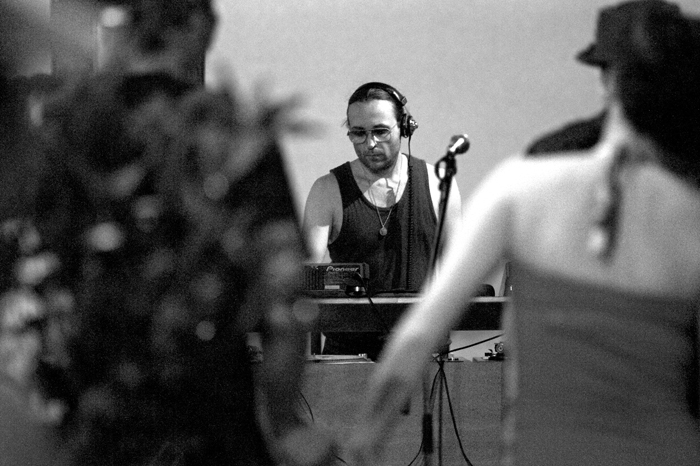I haven’t been dancing in over a year. As I’ve grown older, and as the comedowns that once lasted an afternoon have come to extend for days, my desire to flex my avuncular moves in public has dwindled (although I should confess that decamping to a writer’s residency in the Canadian Rockies for three months has, perhaps, accelerated the process). But – to dress up the symptoms of my ageing in artspeak – I might also say that my recent absence from the dancefloor reflects a shift in my relation to the social dynamics of contemporary art.
The closest I’ve been to a DJ booth recently was karaoke night at Bruno’s Bar & Grill here in Banff. The bruised alliteration of that phrase captures the mood of the place: thick-necked, bearded Canadians in trucker caps nursing IPAs at the bar, gloomily refusing to acknowledge the singers busting lungs on the makeshift stage behind them. I watched as Justin – a local celebrity who moonlights as a waiter in a Chinese restaurant – launched into a monotone rendition of Everybody Knows (1975) by Leonard Cohen. By most musical metrics it was an appalling performance, but an oddly affecting one. I thought of Andy Kaufman’s deadpan Dadaism, minus the startlingly convincing Elvis impersonations. “The poor stay poor, the rich get rich,” sang Justin. I cheered him on.
Much of my dancing until recently took place at gallery afterparties, at which, inevitably, an artist would be DJ’ing. Those parties appear in retrospect as just another part of the entertainment-industrial complex: less an escape from the stresses of professional life than a networking session with free beats (the DJ rarely got paid) and free booze. Artists of previous generations formed bands; now they spin records. I grew accustomed to the artist-as-amateur-DJ archetypes: the ‘kooky’ artist whose cheesy tunes induced flashbacks to dancefloors at weddings; the cheerfully inept enthusiast whose every mix was a musical car crash; the postironic hipster who dropped Hotline Bling (2016) five times; the white bro who spun grime to look street. At their worst, these parties collapsed the distinction between clubbing and networking, leisure and labour, sucked the fun out of dancing with friends. As Cohen wrote and Justin interpreted: “Everybody knows the deal is rotten”.
Artists can also be very good DJs, as Juliana Huxtable proved via a memorably jagged set at an afterparty a few years ago. But the few who are equally skilled in both fields can be ambivalent about operating across the different economies of clubs and galleries. In a recent interview, Huxtable (the cofounder of ‘nightlife gender project’ Shock Value) described moving from Texas to New York, where the clubs were ‘way more diverse than any other self-identified creative, left-of-centre space, you know?’ In clubs ‘there are trans women older than me who I can look up to’; which begs the question of whether art spaces, for all their declared commitments to diversity, can offer the same sense of community and connection.
I’ve seen the trans artist, composer and deep house producer Terre Thaemlitz perform as DJ Sprinkles so many times that my memories have collapsed into a blur. She is clear-eyed about the compromises artists who DJ are forced to make, and says she works as Sprinkles out of economic necessity. I’ve had more fun dancing to Sprinkles’s sets than anyone else’s, but I’m also acutely conscious of having seen her in clubs with a different (whiter, straighter) clientele than the sex worker-friendly, HIV/aids-activist venues in which she found a community after moving to New York during the 1980s (because those are the clubs that can afford to pay the airfare over from Japan, where she now lives). And I’m equally conscious of my unearned nostalgia for a midtown Manhattan scene kept alive in Thaemlitz’s words – she has been critical of the gentrification of those underground scenes and spaces – and her record choices – as a remembrance of dancefloors past. Echoing Huxtable, Thaemlitz has made clear that the euphoria of clubbing is secondary to its community, specifically the ‘intergenerational trans scene’ in which knowledge – how to stay safe, access hormones – is passed on. In her track Ball’r (Madonna-Free Zone) (2008), Sprinkles rails against Madonna’s “decontextualised, reified, corporatized, liberalized, neutralized, asexualized, regenderized pop reflection” of voguing in her 1990 record. The aforementioned forms of support and exchange are lost when club cultures are transposed into art spaces, when subculture is transformed into karaoke. “Everybody knows the scene is dead,” Justin sang.
Patrick Langley is a critic and novelist based in London
From the December 2019 issue of ArtReview
